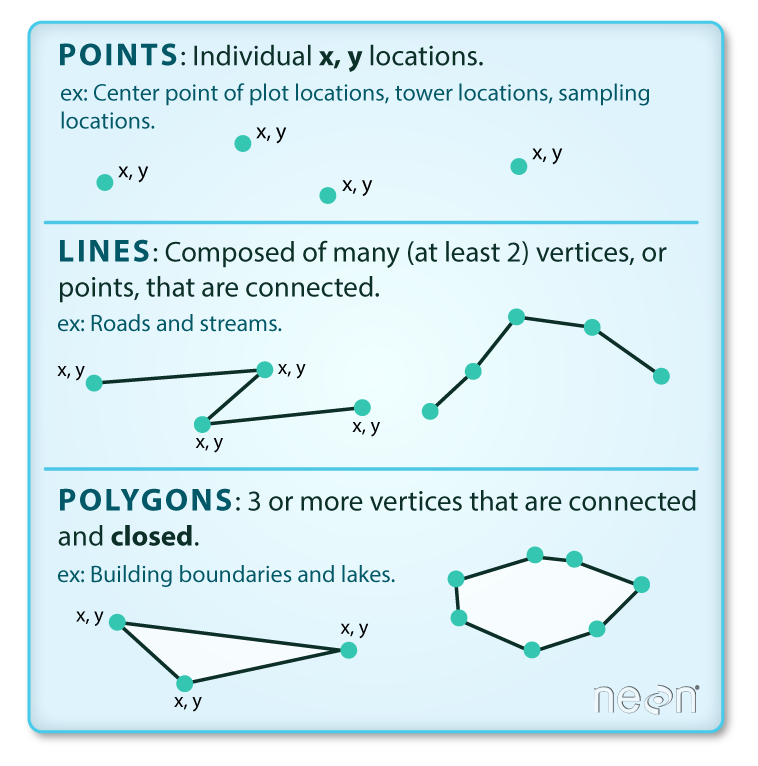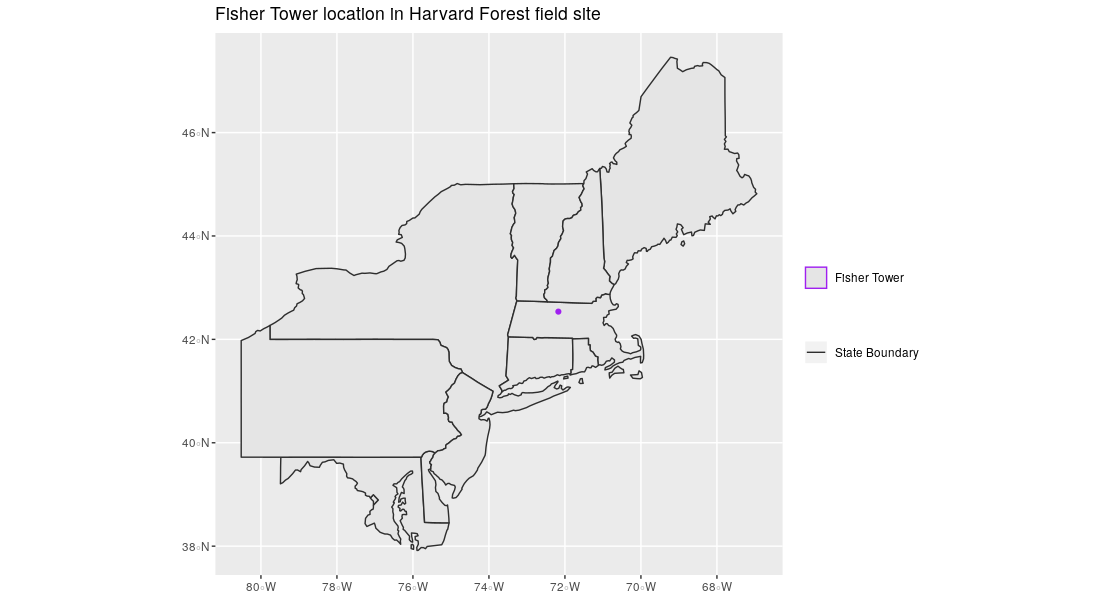Introduction to Vector Data
Last updated on 2025-02-25 | Edit this page
Overview
Questions
- What are the main attributes of vector data?
Objectives
- Describe the strengths and weaknesses of storing data in vector format.
- Describe the three types of vectors and identify types of data that would be stored in each.
About Vector Data
Vector data structures represent specific features on the Earth’s surface, and assign attributes to those features. Vectors are composed of discrete geometric locations (x, y values) known as vertices that define the shape of the spatial object. The organization of the vertices determines the type of vector that we are working with: point, line or polygon.

Points: Each point is defined by a single x, y coordinate. There can be many points in a vector point file. Examples of point data include: sampling locations, the location of individual trees, or the location of survey plots.
Lines: Lines are composed of many (at least 2) points that are connected. For instance, a road or a stream may be represented by a line. This line is composed of a series of segments, each “bend” in the road or stream represents a vertex that has a defined x, y location.
Polygons: A polygon consists of 3 or more vertices that are connected and closed. The outlines of survey plot boundaries, lakes, oceans, and states or countries are often represented by polygons. Note, that polygons can also contain one or multiple holes, for instance a plot boundary with a lake in it. These polygons are considered complex or donut polygons.
Data Tip
Sometimes, boundary layers such as states and countries, are stored as lines rather than polygons. However, these boundaries, when represented as a line, will not create a closed object with a defined area that can be filled.
Identify Vector Types
The plot below includes examples of two of the three types of vector objects. Use the definitions above to identify which features are represented by which vector type.

State boundaries are shown as polygons. The Fisher Tower location is represented by a purple point. There are no line features shown. Note, that at a different scale the Fischer Tower coudl also have been represented as a polygon. Keep in mind that the purpose for which the dataset is created and aimed to be used for determines which vector type it uses.
Vector data has some important advantages:
- The geometry itself contains information about what the dataset creator thought was important
- The geometry structures hold information in themselves - why choose point over polygon, for instance?
- Each geometry feature can carry multiple attributes instead of just one, e.g. a database of cities can have attributes for name, country, population, etc
- Data storage can, depending on the scale, be very efficient compared to rasters
- When working with network analysis, for instance to calculate the shortest route between A and B, topologically correct lines are essential. This is not possible through raster data.
The downsides of vector data include:
- Potential bias in datasets - what didn’t get recorded? Often vector data are interpreted datasets like topographical maps and have been collected by someone else, for another purpose.
- Calculations involving multiple vector layers need to do math on the geometry as well as the attributes, which potentially can be slow compared to raster calculations.
Vector datasets are in use in many industries besides geospatial fields. For instance, computer graphics are largely vector-based, although the data structures in use tend to join points using arcs and complex curves rather than straight lines. Computer-aided design (CAD) is also vector- based. The difference is that geospatial datasets are accompanied by information tying their features to real-world locations.
Vector Data Format for this Workshop
Like raster data, vector data can also come in many different formats. For this workshop, we will use the GeoPackage format. GeoPackage is developed by the Open Geospatial Consortium and is is an open, standards-based, platform-independent, portable, self-describing, compact format for transferring geospatial information (source: https://www.geopackage.org/). A GeoPackage file, with extension .gpkg, is a single file that contains the geometries of features, their attributes and information about the coordinate reference system (CRS) used.
Another vector format that you will probably come accross quite often
is a Shapefile. Although we will not be using this format in this lesson
we do believe it is useful to understand how the Shapefile format works.
Shapefile is a multi-file format, with each shapefile consisting of
multiple files in the same directory, of which .shp,
.shx, and .dbf files are mandatory. Other
non-mandatory but very important files are .prj and
shp.xml files.
- The
.shpfile stores the feature geometry itself -
.shxis a positional index of the feature geometry to allow quickly searching forwards and backwards the geographic coordinates of each vertex in the vector -
.dbfcontains the tabular attributes for each shape. -
.prjfile indicates the Coordinate reference system (CRS) -
.shp.xmlcontains the Shapefile metadata.
Together, the Shapefile includes the following information:
- Extent - the spatial extent of the shapefile (i.e. geographic area that the shapefile covers). The spatial extent for a shapefile represents the combined extent for all spatial objects in the shapefile.
- Object type - whether the shapefile includes points, lines, or polygons.
- Coordinate reference system (CRS)
- Other attributes - for example, a line shapefile that contains the locations of streams, might contain the name of each stream.
Because the structure of points, lines, and polygons are different, each individual shapefile can only contain one vector type (all points, all lines or all polygons). You will not find a mixture of point, line and polygon objects in a single shapefile.
More Resources on Shapefiles
More about shapefiles can be found on Wikipedia. Shapefiles are often publicly available from government services, such as this page containing all administrative boundaries for countries in the world or topographical vector data from Open Street Maps.
Why not both?
Very few formats can contain both raster and vector data - in fact, most are even more restrictive than that. Vector datasets are usually locked to one geometry type, e.g. points only. Raster datasets can usually only encode one data type, for example you can’t have a multiband GeoTIFF where one layer is integer data and another is floating-point. There are sound reasons for this - format standards are easier to define and maintain, and so is metadata. The effects of particular data manipulations are more predictable if you are confident that all of your input data has the same characteristics.
- Vector data structures represent specific features on the Earth’s surface along with attributes of those features.
- Vector data is often interpreted data and collected for a different purpose than you would want to use it for.
- Vector objects are either points, lines, or polygons.
